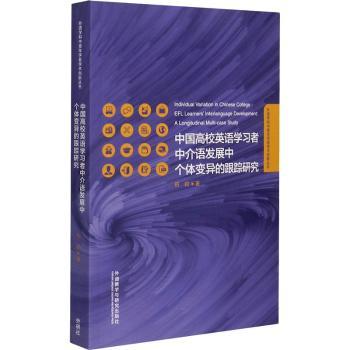内容简介
本书在动态系统理论的视阈下,通过对四名英语学行跟踪研究,对他们中介语发展的过行描述,并通过对比找出了个体内及个体间中介语发展的变异。 本书所提出的二语发展路径强调了中介语发展阶段的主要任务是语言变式的分布和使用越来越目的语。本书还发现词汇深度知识的发展与句子结构的发展方式不同结出英语学介语发展的四种类型,并通过实证方法探讨了造成中介语发展个体变异的影响因素,提出了造成中介语变异的高阶组合及主要影响因素。 本书的研究发现有助于学界对二语展规律的探讨,并对中国英语教学有的指导意义。
目录
Chapter 1 Introduction 1.1 importance of Interlanguage Variation 1.2 Rationale for the Study 1.3 Interlanguage as a Complex Dynamic System 1.4 Objective and Significance of the Current Research 1.5 Organization of the DissertationChapter 2 Literature Review 2.1 Research on Interlanguage Variation 2.1.1 Typology of Interlanguage Variation 2.1.2 Theoretical Research on Interlanguage Variation 2.1.3 Empirical Research on Interlanguage Variation 2.1.4 Research on Chinese EFL Learners' Interlanguage Variation 2.2 Research on Influencing Factors of Interlanguage Variation 2.2.1 Traditional Research on Relationships Between Individual Differences and L2 Learning 2.2.2 The Exploration of Influencing Factors from the DST Perspective 2.3 SummaryChapter 3 Research Methodology 3.1 Research Questions 3.2 Participants 3.3 Research Design 3.4 Data Collection Methods 3.4.1 Compositions 3.4.2 Sociohnguistic Interviews 3.4.3 Es 3.4.4 Language Experience Interviews 3.4.5 Stimulated Recalls 3.4.6 Other Resources 3.5 Data Analysis Methods 3.5.1 The Transcription of Oral Data 3.5.2 The Coding of Variation in L2 Development 3.5.3 The Coding of the Influencing Factors 3.6 The Role of the Researcher 3.7 Ethical ConsiderationsChapter 4 Individual Case Descriptions 4.1 Wu: A Beginner Bre Through from Nontarget-like Variants 4.1.1 A Profile of Wu 4.1.2 Development in Wu's Use of Sentence Patterns 4.1.3 Development and Features in Wu's Lexicon 4.1.4 Factors Facilitating Wu's L2 Development 4.1.5 Summary 4.2 Wang: A Lower-Intermediate Learner Struggling in Erratic Language 4.2.1 A Profile of Wang 4.2.2 Development and Features in Wang's Syntax 4.2.3 Features in Wang's Lexicon: Erratic Use 4.2.4 Factors Facilitating or Constraining Wang's Interlanguage Development 4.2.5 Summary 4.3 Zhao: An Upper-Intermediate Learner Whose Language Fossilized 4.3.1 A Profile of Zhao 4.3.2 Change and Features in Zhao's Use of Sentence Patterns 4.3.3 Features in Zhao's Lexicon 4.3.4 Factors Constraining Zhao's Language Learning 4.3.5 Summary 4.4 Lin: An Advanced Learner Who Practiced to Be Perfect 4.4.1 A Profile of Lin 4.4.2 Development and Features in Lin's Use of Sentence Patterns 4.4.3 Features in Lin's Lexicon 4.4.4 Factors Facilitating Lin,s Language Development 4.4.5 SummaryChapter 5 Cross-case Analysis and Discussion 5.1 Route of Interlanguage Development 5.1.1 A Tentative Proposal on the Developmental Sequence of Linguistic Items: A Continuum 5.1.2 Developmental Order in the Subsystems of Interlanguage 5.2 Variation in Interlanguage Development 5.2.1 Variation in the Developmental Rate of Linguistic Items 5.2.2 Inter-personal Variation in Intedanguage Development 5.3 Influencing Factors of Individual Variation in L2 Development 5.3.1 Initial Conditions 5.3.2 Higher Order Combination of Learner Factors 5.3.3 Interaction Between the Learner Factors and Environmental Factors 5.4 SummaryChapter 6 Conclusion 6.1 Summary of the Major Findings 6.2 Pedagogical Implications 6.3 Contributions of the Present Study 6.4 Limitations and Suggestions for Further ResearchBibliographyAppendix I Sample Essays of the Four ParticipantsAppendix II Sample Es of the Four ParticipantsAppendix III Sample Transcription of the Interviews Between the Native Speakers and the ParticipantsAppendix IV Topics and Rubrics for the CompositionsAppendix V Schedule of Interviews with Native SpeakersAppendix VI Schedule of Interviews with the ResearcherAppendix VII List of EmaUs to Native SpeakersAppendix VIII Schedule of Stimulated Recalls



